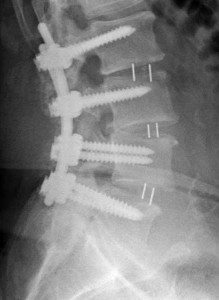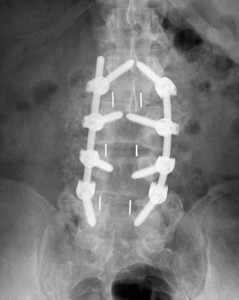Lumbar Spinal Fusion
A spinal fusion surgery is designed to stop the motion at a painful vertebral segment.
There are several approaches to achieve a lumbar spinal fusion:
Anterior: through the abdomen
Lateral: through the flank
Posterior: through the back
In some cases a combination of approaches is indicated to achieve the best result.
In general, fusion procedures also involve a decompression of trapped nerves or narrowed bony structures (spinal canal, neuro foramen).
Often a removal of the intervertebral disc of this segment is required (discectomy).
Using a combination of spinal implants (cages, screws, rods) a primary stability is achieved by the end of the operation.
In order to secure a bony fusion with long-term stability, a bone graft material is used between vertebrae. The graft can be taken from the patients own bone (autograft), processed bone from other patients (allograft), bone substitute material (artificial bone) and sometimes bone growth enhancing substances (BMP) are mixed in as well.
Indications for a spinal fusion.
Lumbar Fusion may be considered where the patients’ back pain and/or inability to function and be pinpointed to abnormal or excessive motion at of a vertebral segment. This occurs commonly in the following:
- Lumbar Degenerative Disc Disease
- Lumbar Spondylolisthesis (vertebral slip)
Other conditions that may be treated by a spinal fusion surgery include a weak or unstable spine (caused by infections or tumors), fractures, scoliosis or other deformity.

